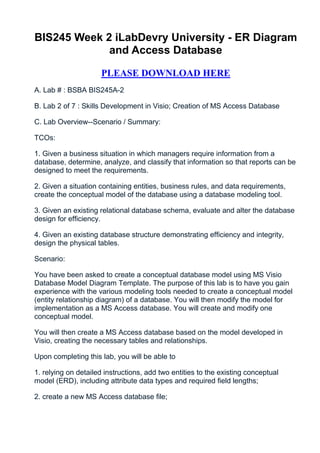Bis245 week 2 i lab devry university er diagram and access database
•Télécharger en tant que DOCX, PDF•
0 j'aime•158 vues
Signaler
Partager
Signaler
Partager

Recommandé
Contenu connexe
En vedette
En vedette (20)
Product Design Trends in 2024 | Teenage Engineerings

Product Design Trends in 2024 | Teenage Engineerings
How Race, Age and Gender Shape Attitudes Towards Mental Health

How Race, Age and Gender Shape Attitudes Towards Mental Health
AI Trends in Creative Operations 2024 by Artwork Flow.pdf

AI Trends in Creative Operations 2024 by Artwork Flow.pdf
Content Methodology: A Best Practices Report (Webinar)

Content Methodology: A Best Practices Report (Webinar)
How to Prepare For a Successful Job Search for 2024

How to Prepare For a Successful Job Search for 2024
Social Media Marketing Trends 2024 // The Global Indie Insights

Social Media Marketing Trends 2024 // The Global Indie Insights
Trends In Paid Search: Navigating The Digital Landscape In 2024

Trends In Paid Search: Navigating The Digital Landscape In 2024
5 Public speaking tips from TED - Visualized summary

5 Public speaking tips from TED - Visualized summary
Google's Just Not That Into You: Understanding Core Updates & Search Intent

Google's Just Not That Into You: Understanding Core Updates & Search Intent
The six step guide to practical project management

The six step guide to practical project management
Beginners Guide to TikTok for Search - Rachel Pearson - We are Tilt __ Bright...

Beginners Guide to TikTok for Search - Rachel Pearson - We are Tilt __ Bright...
Bis245 week 2 i lab devry university er diagram and access database
- 1. BIS245 Week 2 iLabDevry University - ER Diagram and Access Database PLEASE DOWNLOAD HERE A. Lab # : BSBA BIS245A-2 B. Lab 2 of 7 : Skills Development in Visio; Creation of MS Access Database C. Lab Overview--Scenario / Summary: TCOs: 1. Given a business situation in which managers require information from a database, determine, analyze, and classify that information so that reports can be designed to meet the requirements. 2. Given a situation containing entities, business rules, and data requirements, create the conceptual model of the database using a database modeling tool. 3. Given an existing relational database schema, evaluate and alter the database design for efficiency. 4. Given an existing database structure demonstrating efficiency and integrity, design the physical tables. Scenario: You have been asked to create a conceptual database model using MS Visio Database Model Diagram Template. The purpose of this lab is to have you gain experience with the various modeling tools needed to create a conceptual model (entity relationship diagram) of a database. You will then modify the model for implementation as a MS Access database. You will create and modify one conceptual model. You will then create a MS Access database based on the model developed in Visio, creating the necessary tables and relationships. Upon completing this lab, you will be able to 1. relying on detailed instructions, add two entities to the existing conceptual model (ERD), including attribute data types and required field lengths; 2. create a new MS Access database file;
- 2. 3. using the model from Parts A and B of the lab, and relying on detailed instructions; create the first two tables in the database; 4. use the experience gained in creating the first two tables to add the remaining tables; 5. using the model from Parts A and B of the lab, and relying on detailed instructions; create the relationship between the first two tables in the database; and 6. use the experience gained in creating the first relationship to create the remaining relationships between the tables.